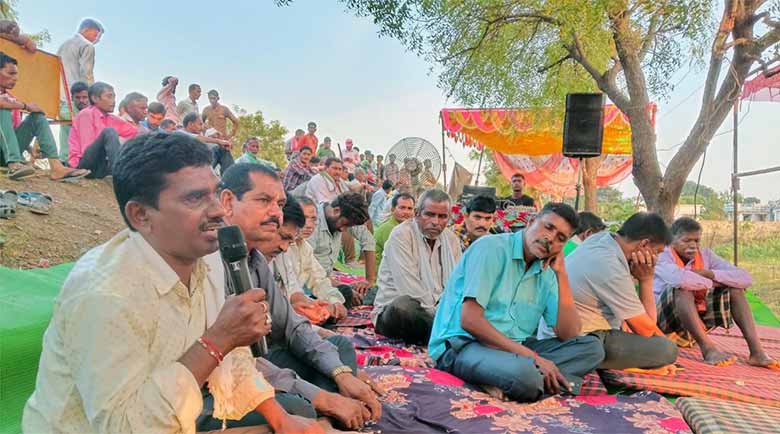Bemetara villagers protest Ethanol Plants over pollution fears
Bemetara | Correspondent: Residents of Patharra village in Bemetara district are protesting against the establishment of ethanol plants in the gram panchayat Bhainsa region, expressing their concerns over environmental pollution and its impact on future generations.
For the past 13 days, villagers including women, men, youth, and children from Patharra and neighboring villages like Raka, Bitkuli, Vasni, and Kathiya, have united in peaceful demonstrations.
The protesting villagers argue that the ethanol plant will disrupt agricultural activities, which are the primary livelihood for over 25,000 people in the region.
Many are worried that, if the plant becomes operational, it will employ over outsiders, leaving local residents without job opportunities.
They believe the plants will harm local rivers, land, and air quality, leading to a legacy of pollution that will affect water, soil, and agriculture.
Protests erupt for new ethanol plants in Chhattisgarh
Protesters are demanding answers on how water and air pollution will be managed, questioning the decision-making behind the projects.
The movement emphasizes the importance of addressing environmental concerns for the well-being of current and future generations.
“We want our state to be beautiful and thriving,” said one protester, echoing the sentiments of the community.
Protesters raise environmental concerns over factory operations
Fearing adverse effects on their community, protesters have raised serious environmental concerns regarding the factory’s operations.
Despite being required to implement a Zero Liquid Discharge system, locals report that untreated wastewater is being released into a nearby irrigation canal, heightening fears of water contamination.
In addition, villagers have complained of a strong, unpleasant odor and polluted air emanating from the factory, indicating potential air quality issues that could pose health risks.
Furthermore, reports of significant crop damage have emerged, with farmers linking pollutants from the factory to a decline in both the quality and yield of their paddy crops.
Witness the consequences
Retired lecturer Pramil Tiwari told CGKHABAR, “My house is 7 kilometers away from the Bhainsa area, and not only my family but the entire village suffers from the foul odor that emanates from the plant.
“Additionally, the waste released into the water bodies contributes to pollution. While the collector and other officials assure the public that measures are in place to minimize odor and pollution, I personally invite them to visit the area and witness the consequences that nearby residents are enduring.”
Some residents have expressed strong opposition to the plants, citing concerns about pollution and the suitability of the industrial setup in an area traditionally focused on agriculture.
Community leaders from the Chhattisgarh Kisan Sangh, have voiced their preference for agricultural-focused factories, arguing that the current plans may not align with the district’s agricultural identity and regulations.
Bemetara shifts from Agriculture to Industry amid concerns
Bemetara, historically recognized as an agricultural district in Chhattisgarh, is currently undergoing a significant transition toward industrial development.
The state has announced plans to establish 11 ethanol and three sponge iron plants in the region, marking a pivotal shift in its economic landscape.
Construction has already commenced on three ethanol plants and one sponge iron facility, with the Patharra ethanol plant set to begin production as early as November.
With over 90% of the Patharra ethanol plant’s construction completed, authorities have assured the community that the technology being implemented is designed to minimize odor and pollution through a specialized digester system that treats waste and recycles water for use within the facility.
Villagers reject NOC for proposed ethanol plant in Bemetara last year
One year ago, villagers in Bhainsa, Bemetara, unanimously decided not to grant a No Objection Certificate (NOC) for a proposed ethanol plant, citing concerns over environmental pollution and potential crime.
Despite officials from the plant corporation presenting the project’s benefits, the community, led by Sarpanch, maintained their opposition.
This decision marked a growing resistance to industrial projects in the agricultural district.
Previous efforts to establish a sponge iron plant in Berla also faced similar opposition from farmers.
While discussions about agriculture-based industries have continued, the villagers have remained determined to protect their land from non-agricultural developments.
State plan
Meanwhile, where Chhattisgarh is planning to set up 11 ethanol plants in Bemetara and 29 across Chhattisgarh, raising questions about the sustainability of sourcing enough paddy for these facilities.
State’s first ethanol plant set up in the Kabirdham district is suffering ceased functioning.
Chhattisgarh first Ethanol Plant
Chhattisgarh’s first ethanol plant was set up in the Kabirdham district under a public private partnership model in the year 2023.
The ethanol plant was set up with a capacity to produce 80 kilo liters per day (KLPD), positioning it as a medium-scale ethanol production facility.
Built at a cost of Rs 150 crore, the plant was expected to boost local agriculture and provide employment opportunities. However, just some months into operation, the facility has ceased functioning.
Concerns have now arisen about the plant’s financial management, with reports suggesting losses due to company negligence. Plant officials have attributed the shutdown to a lack of raw materials.
Issues the local people in Kabirdham facing
A resident of the district shared concerns about the odor and waste material released into the environment, which is severely affecting the people living in the region.
The pollution caused is having a detrimental impact on both the people and the environment.
The ethanol industry not only releases its waste material into open fields, but the waste often catches fire shortly after discharge, releasing harmful gasses into the air.
India fast-tracks ethanol blending target to 2025-26
The Indian government introduced the National Policy on Biofuels in 2018, aiming to blend 20% ethanol with petrol by 2030 to reduce the country’s dependence on fossil fuels and lower pollution.
Back in 2014, only 1.5% ethanol was mixed with petrol in India. However, due to positive results and several steps taken by the government to promote ethanol production, this target was moved up to 2025-26, meaning the goal is now to achieve 20% ethanol blending five years earlier than originally planned.
Ethanol’s green benefits questioned by experts
The government claims that ethanol helps vehicles burn fuel more cleanly, reducing harmful emissions like hydrocarbons, carbon monoxide, and particulate matter. A 20% ethanol blend in cars can cut carbon monoxide emissions by 30% and hydrocarbons by 20% compared to using only petrol.
When burned, ethanol produces 20-40% less carbon dioxide than regular fuels and is considered carbon-neutral because plants absorb CO2 as they grow.
However, experts warn that this overlooks the greenhouse gas emissions from ethanol production. Research from the US suggests ethanol’s carbon intensity may be 24% higher than petrol, due to factors like land-use changes, increased fertilizer use, and damage to ecosystem.
Agriculture experts argues that ethanol can be just as carbon-intensive as petroleum, considering the environmental impact of growing crops, water use, and the ethanol production process. They points to Germany, which is now discouraging large-scale single-crop farming due to these concerns.




